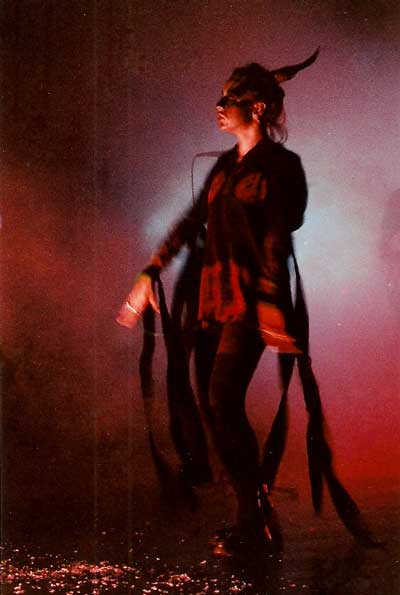Twice a Man / Selected Work

Fungus & Sponge 1993
A Dreamlike Expansion of the Audiofield
The sky above the port was the color of television,
tuned to a dead channel.
The whole thing started with an idea to create an opera based upon William Gibsons novel "Neuromancer" (1984).
This novel can well be described as the bible of cyberpunk.
The story takes place in a fictitious future, where multinational business concerns control society and people rush around in their attempts to find cracks in a monolithic system. Drugs are an unavoidable part of everyday life. In this world, the "cyberspace" of the computer network is infiltrated and exploited by so called "console cowboys"; hackers who steal and divert information to serve their own subversive purposes.
The overall atmosphere in "Neuromancer", an influence upon many, is emotionally charged in a way which is reminiscent of, for example, films such as "Stalker", "Blade Runner" and "Akira". The darkly poetic vision of the future presented in "Neuromancer" has been a great source of inspiration to us. That Twice a man should be attracted to such material is hardly surprising considering their multimedia show "Driftwood" {1988), which is similar to Gibsons work in terms of overall atmosphere, but written from a specifically nordic enviromental perspective. That the beach where "Driftwood" takes place was the same beach as Wintermute, the artificial intelligence, created in "Neuromancer" could not be known to us then, as we had not read Gibsons book. With hindsight the connection is obvious. "Fungus and Sponge" contains three songs with moods or situations influenced by "Neuromancer".
In Chiba Sky we meet the protagonist Case strung out on and confused by drugs, lost deep in a chaotic city somewhere in the 21st century, seeking solace in the automatic voices ... Panther Modems is the collective name given to the "cyberpunks" of the book, which Gibson himself describes as "Nihilistic Technofetishists". Together with Case and his companion Molly they infiltrate the Sense/Net Pyramid; Panic breaks out when the dangerous chemical Blue Nine is released into its ventilation system.
It's Time to Dream finds us travelling across the artificial beach, surrounded by wind, surf and blocks of ice. Our minds are like scientists, our scenses are our instruments, the world is our experiment Gibsons "cyberspace" is synonymous with "Virtual Reality", i.e. computer generated artificial worlds, which are entered via computer interface. VR technology has, in recent years,
been developing at an ever increasing pace. All over the world computer research labs are constantly developing that which will become the next great medium for communication. VR is still a medium in its infancy, but it bears a vision of a not too distant future in which it could revolutionise our existence. At the very moment hordes of 8- year olds sit engrossed in sophisticated computer games.
What will happen to us when we can fly over the surface of Mars, have sex with three-dimensional computer animations or, as in Strange Delight, dance with Fred Astaire? VR looks set to be an entertainment source that we can hardly begin to imagine the future extent of. However, VR is not merely entertainment. Even now, fully workable 3-D programs are used in a variety of areas; Surgeons can practice complicated operations upon "virtual" patients. Architects can walk in "virtual" buildings, while their ideas are still no more concreate than blueprints. VR will become what we make it.
In the present it is like a blank canvas, where the only limits are set by the extent of human imagination.
In Dorothy sampled voices, soundscapes and diverse rythms are placed to create a multicultural journey in the realms of VR-technology. This journey continues in Reality Built for Two, where description becomes experience. Sheltering Sky hints at a fear of becoming trapped in this unreal "virtual" worlds.
I follow the changing moods of waterlily petals.
Another source of inspiration for "Fungus & Sponge" is "Island", Aldous Huxleys vision of the future from 1962. This is not the first time Huxleys work has figured as inpiration for Twice a man. "Driftwood" was inspired partly by the mescaline experiments in "Doors of Perception", and in
"Aqua Marine Drum" (1987) extracts from "Eyeless in Gaza" can be heard. In "Island" one finds many simularities with the spirituality which is sweeping over the 1990s like a tidal wave, but not in the form of (now traditional!!) "new age" thinking. Huxley describes, among other things, an initiation rite, where youths attain enlightment under the influence of the "ideal" hallucinogenic drug Moksha. Shinanayama, is Shiva dancing and the quest for enlightment.
In another place the protagonist describes his own Moksha trip. He experience himself as a Being in Light. We think that by todays standards, Huxleys attitude to drugs is rather naive, but such experimentation can serve as a shortcut, to the broadening of the horizons of sensual perception. In much of the music of the 1990s longing to enter into a trance like situation exists. For us, it is the overall atmosphere of the music which is most important, where that which is superficially static and monotonous is filled with a myriad of details, nuances and displacements, subtly shifting and
interacting. The subtitle to "Fungus & Sponge", "A dreamlike expansion of the Audiofield", describes this. Different sounds unfold in parallel, collide and conspire to create a new dynamic.
One of our aims as manipulators of sound, is to steer the musical drift, to blend tones, pulses and verbal messages together in a composition which communicates directly with the individual listener. To create a world of sound where the listener interacts with the musics structures, and translates them into messages, some familiar, others revelatory.










